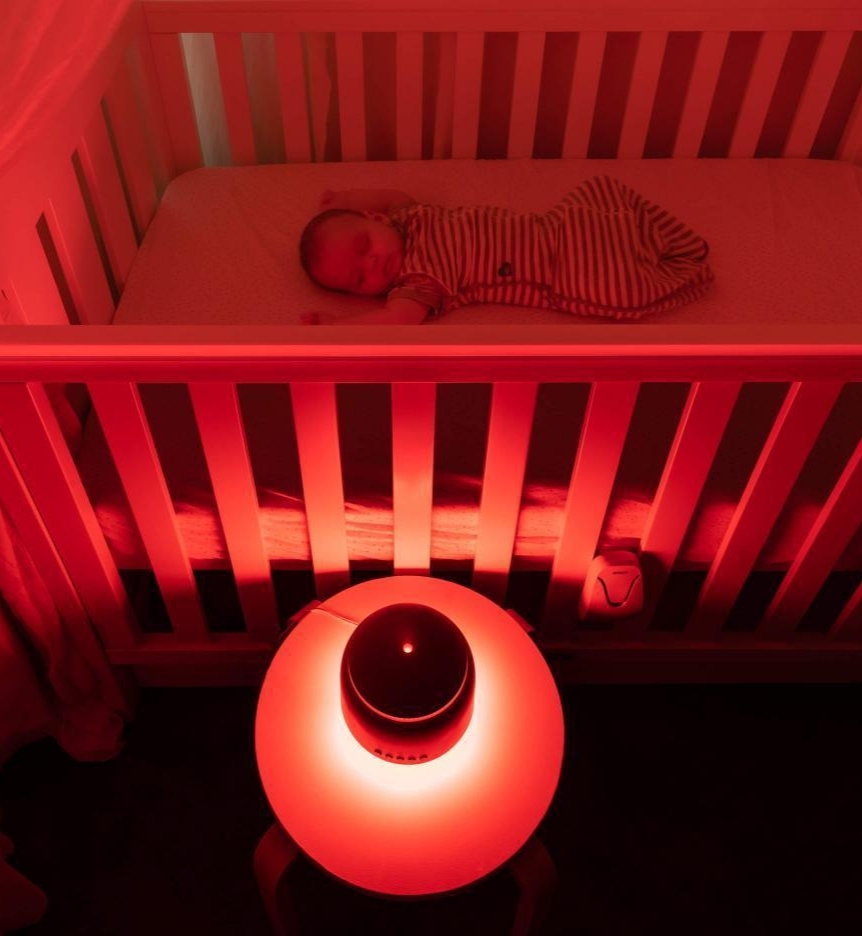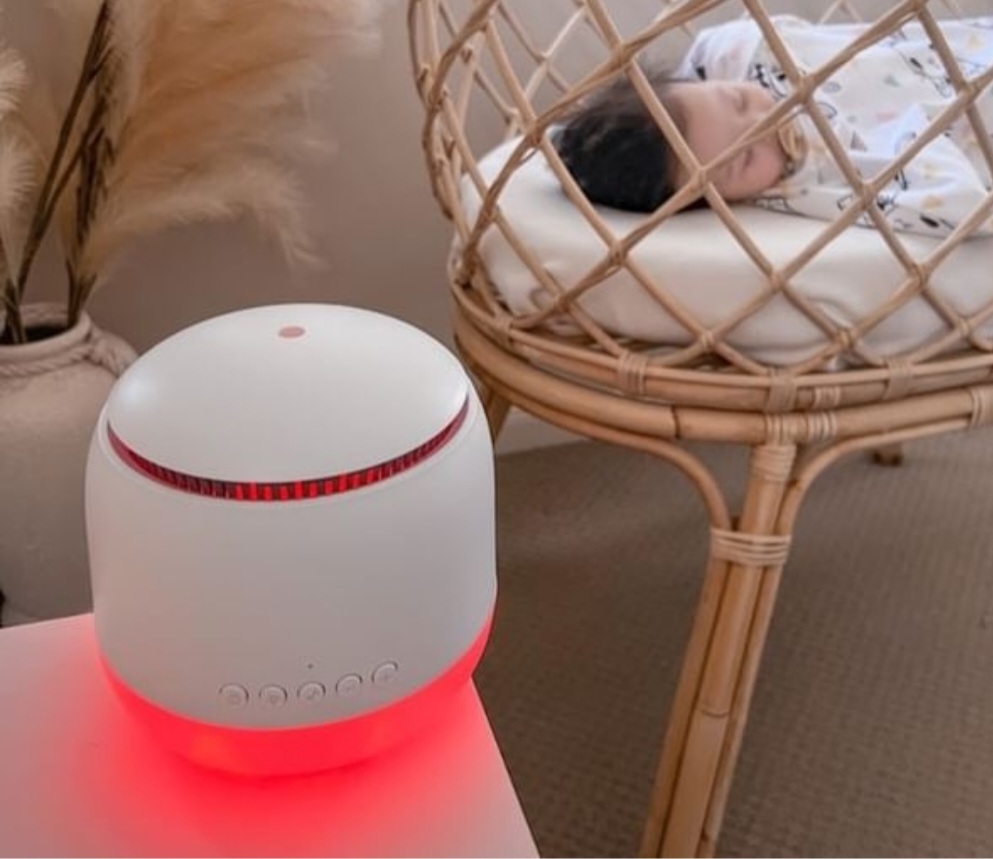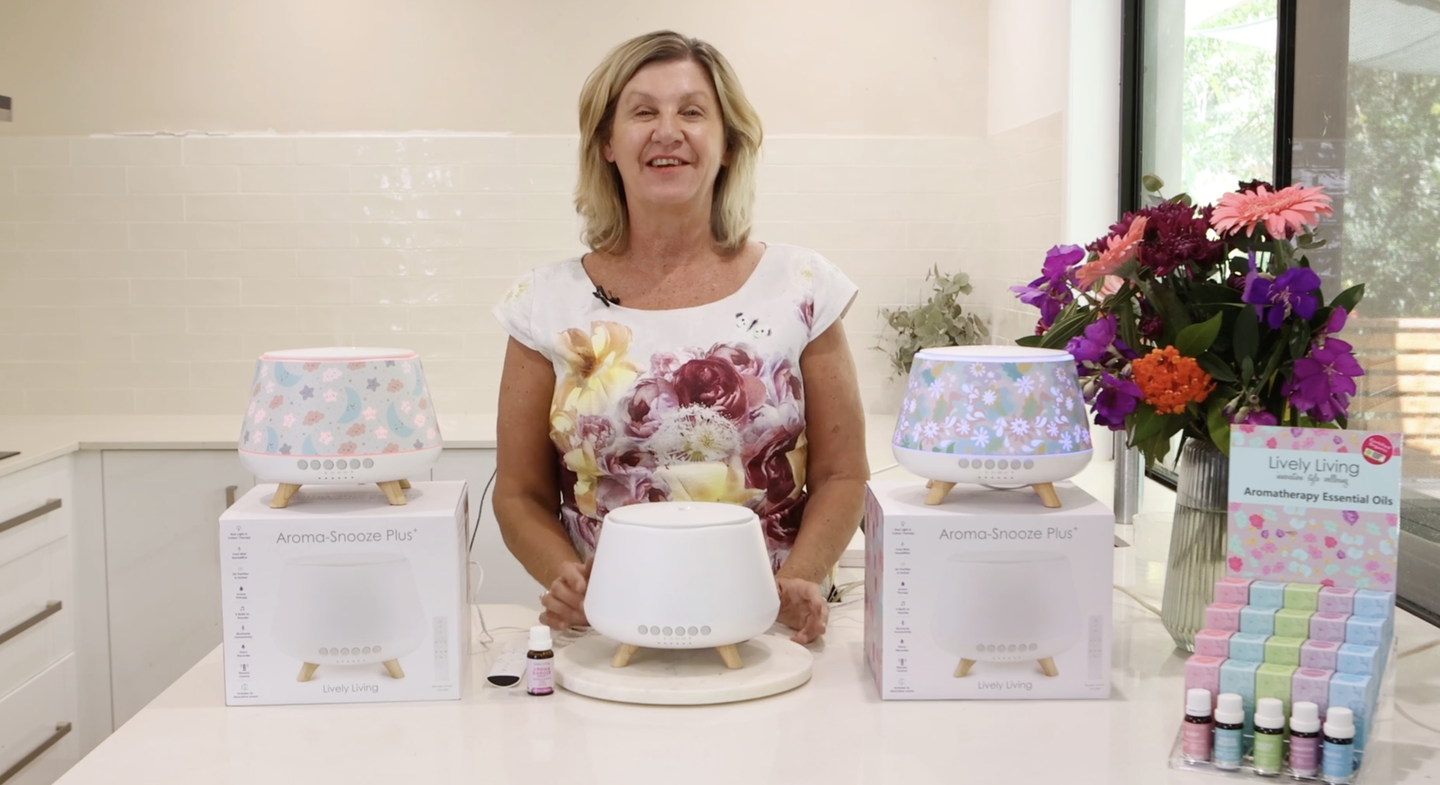Red Night Light Benefits for Children's Restful Sleep
Ever spent a restless night tossing and turning, attending to your Childs sleepless nights, and praying for sleep to come? Picture this: Your little one's room bathed in the gentle glow of a red night light. They are now drifting off to sleep.
What if I told you that such a simple switch could work wonders on your child's sleep quality? That it might be the key to ensuring they wake up bright-eyed and bushy-tailed each morning?
Could it be that such a seemingly insignificant change could make such an immense difference in your child's sleep quality?
The mystery is not just in the hue, but also how our physical forms answer to it. Intrigued yet? Read on! The magic behind this nocturnal charm is about unfold...
Table Of Contents:
- The Role of Circadian Rhythm and Melatonin in Sleep
- Red Light Therapy for Sleep Enhancement
- The Detrimental Effects of Blue, White, and Green Lights on Sleep
- The Advantages of Red Night Lights for Children's Sleep Environment
- Addressing Fears and Night Terrors with Red Base Night-Lights
- Creating a Sleep-Friendly Bedroom Environment
- The Negative Effects of Blue Light Exposure Before Bed
- FAQs in Relation to Red Night Light Benefits for Children
- Conclusion
The Role of Circadian Rhythm and Melatonin in Sleep
Our bodies are fine-tuned machines, running on a 24-hour internal clock known as the circadian rhythm. Our bodies possess a built-in timing mechanism, the circadian rhythm, which assists us in falling asleep at night and feeling revitalized when we wake up.
The Development of Circadian Rhythm in Infants
Babies aren't born with a mature circadian rhythm; it develops over time. In fact, research suggests that this process begins around three months after birth, but only becomes fully developed by their first birthday.
This can make sleep patterns erratic for infants, leading to long nights for parents too. Don't fret - it's just part of the normal maturation process for your baby.
The Impact of Melatonin on Sleep Quality
Melatonin plays a crucial role here. Often referred to as the 'sleep hormone', melatonin is released into our bloodstream when darkness falls, signaling to our body that it’s time to rest.
Studies show melatonin does more than just help us nod off – it also regulates body temperature, blood pressure, and glucose levels while we snooze. It helps babies sleep.
Red Light Therapy for Sleep Enhancement
The key to a good night's sleep might just be the color of your light. But not just any color, we're talking about red light therapy. Basing on science, red light therapy can be a powerful aid to those having difficulty sleeping.
The Science Behind Red Light Therapy
Did you know that over 4000 published medical studies have shown the positive effects of light therapy on sleep? These studies highlight how certain wavelengths of light, like red or orange, can help promote better rest.
This has everything to do with our body's circadian rhythm – an internal clock that tells us when to wake up and when to get some shut-eye. It turns out that this 'clock' is highly sensitive to different types of light exposure during day and night times.
How Red Light Therapy Aids Melatonin Production
Melatonin is often called 'the sleep hormone,' as its production increases in darkness and helps signal your body it’s time for bed. Interestingly enough, red light doesn’t suppress melatonin like blue or white lights do but instead supports high levels of its production.
This means using the warm glow of red lighting before bedtime could help make sure you’re giving your brain all the right signals for a peaceful slumber. So next time you're having trouble sleeping, think about switching off those harsh bright lights in favor of calming red ones.
- A higher level of melatonin produced naturally by the body.
- Improved muscle relaxation and decreased anxiety.
- A significant decrease in sleep latency (the time it takes to fall asleep).
So, if you're lying awake at night, staring at your ceiling while counting sheep, or just struggling with getting quality rest - remember this: red light therapy might be exactly what you need. Try something extra to help with sleep and wellbeing - it could be a big game-changer.

Boost your and your childs sleep quality with the science-backed power of red light therapy. This method, validated by over 4000 medical studies, leverages our body's circadian rhythm and enhances melatonin production - a key hormone for peaceful slumber. So instead of counting sheep or staring at the ceiling, consider switching to calming red lights before bed to support restful nights.
The Detrimental Effects of Blue, White, and Green Lights on Sleep
Blue, white, and green lights might look appealing but they can have a harmful impact on sleep. A study by Harvard Medical School showed that these light sources disrupt melatonin production - the hormone vital for quality sleep.
Melatonin's role is to signal our bodies when it's time to wind down. But blue light exposure from devices like smartphones or tablets can delay its release by up to 3 hours according to the Health Harvard report. That means staying awake longer than you intended.
It’s not just electronic gadgets though; regular room lighting often falls into the same spectrum as daylight (blue/green), tricking your body into thinking it’s still daytime. This impacts circadian rhythm - your natural sleep/wake cycle - leading you towards restless nights and groggy mornings.
The Science Behind Light Color Impact On Sleep
You might ask: Why does color matter? It boils down to wavelengths. Blue and green hues, having shorter wavelengths, possess more energy than the longer-wavelength red light. This energy sends alert signals to our brains through special cells in our eyes called ipRGCs (Intrinsically Photosensitive Retinal Ganglion Cells) that react strongly under blue-green illumination. This was discovered in an eye-opening research paper published in the journal Journal of Vision.
Furthermore, the National Institutes of Health conducted a study which revealed that blue light not only suppresses melatonin for roughly double the time as green light, but it also shifts our circadian rhythms.
The Advantages of Red Night Lights for Children's Sleep Environment
Red night lights play a pivotal role in children's sleep environment. They not only provide comfort and safety but also promote healthier sleep patterns. But why is this? Let's take a closer look.
Melatonin, the Sleep Hormone
Children, just like adults, produce melatonin—a hormone that regulates our body clock or circadian rhythm (Sleep Foundation). This essential hormone helps us wind down and prepare for bed when it gets dark outside.
Now here comes the interesting part: red light has little to no effect on melatonin production. So if your child needs some form of lighting at bedtime, a red night light can be an excellent choice—it won't interfere with their natural sleep-wake cycle.
Night Light Color Matters
A study published by PubMed Central (PMC), shows that exposure to blue or white light before bedtime significantly suppresses melatonin levels compared to dim red light—meaning colors matter when choosing a nightlight. Unlike harsher tones like blue or white, soft red hues don't signal 'daytime' to our brains making them perfect for promoting restful slumber in young ones.

Fighting Fear of Darkness
Beyond hormonal regulation though, let’s admit it – darkness can be scary for kids. A faint glow from a gentle-red-toned nightlight provides enough illumination so they're able to see familiar surroundings should they wake up during the wee hours - all while still keeping their room in a 'nighttime' state. This gives them comfort and helps reduce anxiety related to darkness.
Helping Parents Too
A red night light doesn't just help children—it's also beneficial for parents. When you need to check on your child, change diapers, or soothe back to sleep, the soft glow from a red light is less disruptive than switching on overhead lights—a win-win situation.
Think about investing in something the next time you're considering ways to enhance your child's bedtime routine.
fears of the dark, creating a soothing atmosphere for them to fall asleep. Plus, they're handy when you need to check in on your little ones without waking them up. Overall, red night lights are an excellent choice for promoting better sleep and providing comfort during nighttime.
Addressing Fears and Night Terrors with Red Base Night-Lights
Many children are scared of the dark. But, did you know that red base night-lights can help? Unlike regular lights or screens which may disturb sleep, these unique devices create a soothing atmosphere.
The color red is not as harsh on the eyes compared to blue or white light sources. It doesn't interfere with melatonin production, our body's natural sleep hormone. So, it helps maintain your child’s normal sleep cycle while providing comfort.
The Effectiveness of Red Light for Children's Sleep Environment
A study published by Oxford University showed that exposure to red light before bedtime improved both quality and duration of sleep in young people (source). This calming hue aids relaxation, helping kids fall asleep more easily.
Fearful youngsters often feel safer when they can see their surroundings clearly but subtly illuminated at night time. By offering just enough visibility without disrupting slumber-inducing melatonin levels - these soft glow lamps become an effective solution against nighttime anxieties.
Tackling Night Terrors Head-On With Red Lights
Night terrors – those terrifying episodes where your child wakes up screaming – could be managed better with a little bit of 'red'. The gentle illumination from this type of lamp provides reassurance during such frightening moments without waking them fully like brighter lights might do.
- Fact: Studies have shown that sleep disorders, including night terrors, can be significantly reduced by creating an optimal sleep environment.
- Solution: A red base night-light like the Aroma-Snooze provides a sense of security and warmth to your child's room without disrupting their sleep cycle. It also serves as a subtle signal for their bodies that it’s still time for rest, not wakefulness.
Red base night-lights like the Aroma-Snooze are a comforting solution for children scared of the dark. These devices create a calming atmosphere and help maintain normal sleep cycles by not interfering with melatonin production. They provide just enough visibility to soothe nighttime fears, without disrupting restful slumber.
Research has shown that exposure to red light before bedtime can significantly improve the quality of your sleep. This is a proven method and why the Aroma-Snooze is every mums answer to a good night sleep.
Creating a Sleep-Friendly Bedroom Environment
The bedroom environment can greatly impact the quality of your child's sleep. So, it's crucial to create an ambiance that naturally helps their bodies and minds wind down.
Stimulating Nightfall with Red Night Lights
A key element in achieving this is simulating nightfall using red night lights. Unlike blue or white light which interrupt melatonin production red lights are more beneficial for children’s sleep patterns because they support high levels of melatonin production. This helps children fall asleep faster and enjoy deeper, more restful slumber.
In fact, according to one study conducted by the University of Oxford babies exposed to dim red light at bedtime fell asleep 15% quicker than those under standard lighting conditions.
Designing a Quiet and Comfortable Space
Beyond just light color choices though, you also need to ensure the room is quiet and comfortable. Consider adding soft fabrics for bedding or curtains as these can help absorb noise while creating a cozy atmosphere.
An effective way to maintain optimal humidity levels (40-60%)—crucial for healthy respiratory function—is through using humidifiers like our range from Lively Living #. They not only help to maintain a comfortable environment but also provide added benefits like diffusing essential oils for relaxation.
Implementing Routine and Familiarity
Establishing bedtime routines can be incredibly beneficial. Whether it's reading a book, listening to calming music or using the same red night light each evening, these habits signal to your child that it's time to sleep.
A consistent routine fosters a sense of stability and predictability. It helps us to plan our day effectively, reducing stress and anxiety. This can boost productivity, improve mental health, and even enhance sleep quality.
Aroma-Snooze & Aroma-Snooze Plus Sleep Aids
While there is no quick. magical solution for resolving sleep problems, establishing a routine of using a red night light from infancy can help foster a soothing and positive sleep environment for your child.
We take pride in offering a diverse range of red night lights, each equipped with a built in humidifier, air purifier cool mist vaporiser and offers built in music to enhance the sleep routine and so much more .
Introducing the AROMA-SNOOZE ! the perfect tool for a great nights sleep for your little ones. Experience it for your self with our 30-day 'Satisfaction Guarantee' and welcome the restful nights ahead.
Along with this, it's vital to stick to a consistent bedtime routine. Activities like reading a book or playing soft music can act as signals that it's time for sleep. This will not only improve your child's sleep quality but also foster good habits for their future.
The Negative Effects of Blue Light Exposure Before Bed
While the digital age has given us access to endless information and entertainment, it's also introduced a not-so-welcome guest into our bedrooms: blue light. This high-energy visible (HEV) light emitted by our favorite gadgets can disrupt sleep patterns and have serious implications for overall health.
A Harvard study revealed that exposure to blue light suppresses melatonin production more than any other type of light. Melatonin is essential for regulating your body's internal clock, or circadian rhythm, helping you fall asleep at night.
But the effects don't stop there. Research from the National Institutes of Health shows prolonged exposure to HEV can negatively impact mood changes and metabolism rates.
Mood Changes Due To Blue Light Exposure
We all know how cranky we can get after a poor night’s sleep. The culprit might be right in front of your eyes – literally. Prolonged screen time before bed interferes with restful slumber, leading to irritability and even depression over time according to research from the Journal of Psychiatric Research.
The Impact on Metabolism & Energy Levels
You may think catching up on emails or watching late-night TV doesn’t affect much else but your sleep - wrong. When blue light exposure reduces sleep quality, it can slow down your metabolism too. This leads to lower energy levels and weight gain over time.
2 diabetes. Blue light not only affects sleep, but also disrupts melatonin production, which can lead to increased insulin resistance and an elevated risk of type 2 diabetes. According to a study published in the Proceedings of the National Academy of Sciences, this disruption can increase insulin resistance—a condition often linked to type 2 diabetes.
FAQs in Relation to Red Night Light Benefits for Children
Is red light good for kids to sleep with?
Absolutely. Red light supports melatonin production, the hormone that regulates sleep, and it doesn't disrupt the circadian rhythm like blue or white lights do.
Why is red light good for kids?
Red light fosters a peaceful environment conducive to sleep by enhancing melatonin levels and not interrupting their natural body clock.
What color night light is best for kids' sleep?
The best choice would be a red nightlight because it enhances restful sleep without disturbing children's internal clocks.
What are the benefits of a red nightlight?
Besides aiding sounder sleeps, using a red nightlight can also help soothe fears of darkness in children while supporting healthy sleeping patterns.
Conclusion
Understanding the red night light benefits for children can be a game changer. This little switch could lead to restful nights and cheerful mornings.
Melatonin, our sleep hormone, is heavily influenced by light exposure. The color of that light matters significantly.
Red lights promote melatonin production while blue or white lights disrupt it. They create a calm environment conducive to your child's natural sleep patterns.
Avoiding screens before bedtime helps too, since they emit harmful blue light that hampers quality slumber.
To sum up: Swap out regular bulbs with red ones at night; you might just see an improvement in your kid's sleep routine!




















